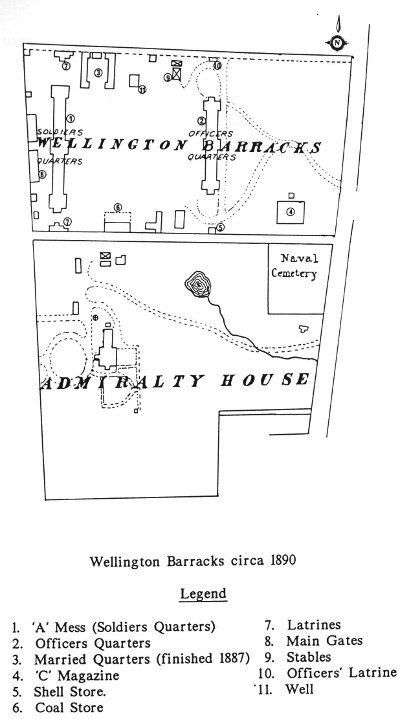Topic: Halifax


Wellington Barracks was one of a number of barracks used to house soldiers of the British Army, and later the Canadian Permanent Force, in Halifax, Nova Scotia. Built on land now occupied by HMCS Stadacona, Wellington Barracks was once the home of The Royal Canadian Regiment when it provided the garrison battalion in Halifax.
The Evolution of the Halifax Fortress; 1749-1928 by Harry Piers (Revised by G.M. Self, Public Archives of Nova Scotia, 1947)
"The destruction by fire (11 December, 1850) of the soldiers' quarters at the North barracks very seriously reduced the available accommodation for the large force on the station ( ... the whole of the North Barracks, with the adjoining Officers' Quarters, Mess Rooms and the contiguous buildings were entirely consumed …), but it was not until seventeen years later that the erection of th present Pavilion Barracks or Married Soldiers Quarters was begun on the site of the old building. Almost immediately after the fire the Halifax Hotel on Hollis Street was leased as quarters for the Officers, and an uproarious time they had there. The rank and file were accommodated thus: the 7th Royal Fusiliers in casemates at the Citadel; the 88th in South Barracks; and the 35th, two companies at George's Island, and other harbour forts, one in the Naval Hospital, and one on the ground floor of the Pavilion Range of the North Barracks."
"Fortunately steps had already been taken to build in another part of the town large and thoroughly modern permanent barracks, later named Wellington Barracks. On 17 July, 1850, Lt. Colonel Savage had sent to England a full description and plans for permanent barracks for a battalion of infantry, to be erected on the Ordnance Field, Gottingen Street, south of Fort Needham; officers' quarters to accommodate two field officers, twenty-four officers and twenty-six servants, enlisted men's barracks for 555 NCO's and privates, and a 40-bed hospital. Authority to proceed with the work was given 30 December 1850, and the preparation of the site apparently begun in 1851. In June, 1852, the tenders of Peters, Blailock, and Peters, of Quebec, £43,271, was accepted; and they commenced work about 1 August, 1852, under the superintendence of Captain Barry, R.E. The buildings were nor complete until April, 1860."
 These new barracks would also be built to the newest standards, meeting the high expectations of the reform movement seeking to improve living conditions then gaining strength in England. Accordingly, as quoted in "A Brief History of Wellington Barracks" by Barbara Winters (1989), it would include:
These new barracks would also be built to the newest standards, meeting the high expectations of the reform movement seeking to improve living conditions then gaining strength in England. Accordingly, as quoted in "A Brief History of Wellington Barracks" by Barbara Winters (1989), it would include:
"...the creation of separate quarters for married soldiers, as well as separate dining facilities, day-rooms, ablution rooms and baths, laundry and drying rooms, They proposed the removal of urine tubs from the barracks, the erection of proper urinals outside the rooms, the replacement of cesspools by a drainage and sewage system and the provision of an abundant water supply."
Wellington Barracks was completed in 1858, but no troops occupied the quarters until 1860. the contract to build the barracks was fraught with problems, including the dismissal of the contractors before all work was completed.
Built originally to house the British Army garrison units at Halifax, the Barracks would house The Royal Canadian Regiment on two occasions. During the first such occasion, it housed part of the 3rd (Special Service) Battalion of The RCR, which was raised between 1899 and 1902 to garrison Halifax while the British Army focused its efforts, and its own battalions, in South Africa. Later, in 1905, when the last British garrisons were removed from Canada and The RCR expanded to create a battalion headquarters and six new companies of infantry at Halifax, Wellington Barracks again became one of the Regiment's homes until the Regiment departed for the First World War.
Wellington Barracks, after being damaged in the Halifax Explosion, was never returned to full use. Its outbuildings were torn down after the Explosion and the property transferred to the Navy in 1941.
